Choosing the Perfect Rug Color for a Beige Couch
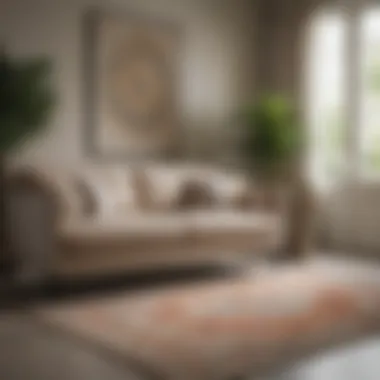
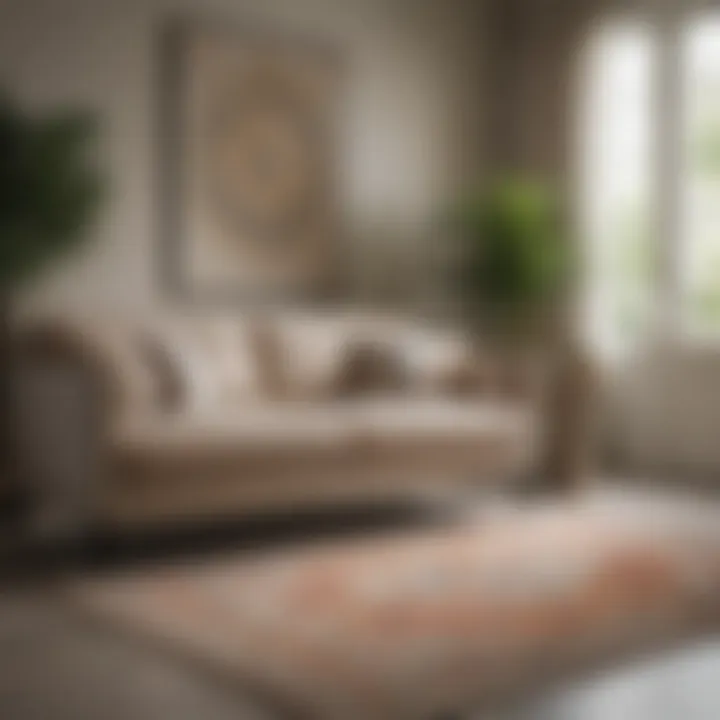
Intro
Choosing a rug color to complement a beige couch can significantly influence the overall aesthetics of your living space. A beige couch serves as a versatile backdrop, capable of accommodating a variety of color schemes and styles. The challenge lies in selecting a rug that not only harmonizes with the couch but also enhances the overall ambiance of the room.
This article will explore key considerations when choosing the ideal rug color, grounded in color theory and practical design insights. Understanding how room size, lighting, and texture impact color perception will be instrumental in making informed decisions.
Moreover, we will utilize practical tips and design inspirations that cater to a diverse range of tastes, ensuring that the final selection resonates with individual preferences.
Design Inspiration
Trending Styles
The first step in choosing the right rug color involves exploring current design trends. Rugs come in numerous styles, each offering distinct visual experiences. For instance, vintage rugs with intricate patterns can bring warmth and character to a space anchored by a beige couch. Alternatively, minimalist designs with solid colors can emphasize clean lines and simplicity.
Some popular trending styles include:
- Bohemian: Featuring an array of colors and patterns, this style infuses energy into the room.
- Scandinavian: Often prioritizing neutral tones and light textures, it creates a serene environment.
- Industrial: Featuring rugged materials and darker shades, this style contrasts beautifully with the softness of beige.
Color Palettes
Once you determine the style, the next step involves selecting a color palette. The color wheel can guide your choices. Opposite colors, or complementary colors, can be effective when paired with beige. For example, deep blues or rich greens provide a striking contrast and bring depth to the space.
Additionally, analogous colors, such as soft browns or muted yellows, can create a cohesive look that feels inviting. Think about the following color combinations:
- Soft gray and beige for an understated yet elegant effect.
- Warm terracotta or burnt orange to add a touch of earthy vibrancy.
- Crisp white accents to create a fresh, modern feel.
"Choosing a rug color that contrasts with a beige couch can elevate the entire design, making the space feel more dynamic and carefully curated."
Practical Tips
Maintenance & Care
Maintaining the beauty of your brand-new rug is vital for longevity. Depending on the material, different cleaning methods will apply. For example, wool rugs are durable and can often withstand heavy foot traffic, while silk requires more delicate care. Regular vacuuming is important, as is addressing spills immediately to prevent stains.
Budgeting & Planning
Finally, consider the budget. Quality rugs can be an investment, and it's practical to allocate funds wisely. Setting a budget that reflects quality while also considering the overall design will help narrow down options effectively. Researching different retailers or considering second-hand options can offer broader choices without compromising style.
Determining the ideal rug color for a beige couch entails reflection on many factors, including personal style and practical considerations. Following these guiding insights can aid in curating a living space that feels well-thought-out and harmonious.
Understanding the Basics of Color Coordination
Color coordination is essential in interior design. It helps create harmonious living spaces that reflect the homeowner's personality and style. For those with a beige couch, understanding color coordination is particularly crucial. This is because beige is a neutral color, which can easily blend or contrast with various rug colors.
Color Theory Fundamentals
At its core, color theory focuses on the relationships between colors and how they can be combined effectively. The color wheel serves as a guiding tool. It shows primary, secondary, and tertiary colors and how they interact. For example, complementary colors are opposite each other on the wheel. When used together, they create a vibrant look. On the other hand, analogous colors sit next to each other. These create a serene and comfortable feel.
When choosing a rug to go with a beige couch, consider the hues on the color wheel. Selecting warm or cool colors that balance with beige can make a space feel cohesive. A soft grey rug, for example, can enhance the beige while keeping the overall tone calm.
Rug colors can also affect the size perception of a room. Light colors can make a space look larger, while darker shades might create a cozy atmosphere.
The Psychology of Color
Colors affect human emotions and behaviors. In interior design, understanding this can help in selecting rug colors. Beige, often associated with warmth and neutrality, evokes a sense of calm. It can create a comfortable environment, making it an ideal backdrop for various rug colors.
Choosing a rug color that resonates with certain feelings can enhance the overall ambience. For instance, blue and green tones can promote relaxation. These colors are often linked to nature and tranquility. In contrast, bright colors like yellow or red can invigorate energy in a space. Understanding these effects is crucial when selecting a rug.
"Color is a power which directly influences the soul."
- Wassily Kandinsky
This understanding of color psychology helps homeowners create spaces that not only look good but also feel good. By keeping these elements in mind, one can achieve a balance that encapsulates both aesthetics and functionality in their interior design.
The Role of Beige in Interior Design
Beige is not just a color; it plays a significant role in the realm of interior design. Its ability to serve as a backdrop makes it a favorite among designers and homeowners alike. In this article, we explore why beige is such an important choice.
First, beige creates a warm and inviting atmosphere. It tends to blend well with various other colors, making it versatile. When one chooses beige for larger pieces, like a couch, it lays a foundation that allows for flexibility in other areas of decoration. It enables the introduction of bolder colors through accessories like cushions or, in this case, a rug.
Second, this neutral color promotes harmony in design. It can soften the impact of more vibrant hues while allowing them to stand out. Beige also offsets cooler tones, which can create a balanced overall aesthetic. This balance is especially valuable in modern artistry, where contrasts are fundamental.
Moreover, beige has unique attributes that contribute to its appeal. Here are some notable characteristics:


- Timelessness: Beige transcends seasonal trends, ensuring that spaces remain stylish over time.
- Good compatibility: It pairs elegantly with a wide range of colors, from soft pastels to deep jewel tones.
- Relaxing impact: Beige evokes a sense of calm, enhancing the comfort of one's living space.
Characteristics of Beige
Understanding beige involves recognizing its characteristics. It is often perceived as a soft, earthy tone that is neither too dark nor too light. This characteristic allows it to adapt to various designs while promoting an elegant and sophisticated aesthetic.
It is an understated shade that lacks the intensity of other colors. This quality ensures that it does not overwhelm a space while still providing depth. The versatility of beige makes it suitable for both traditional and contemporary designs, appealing to a broad range of tastes.
The color may appear different in various contexts, influenced by surrounding elements, light, and textures. For example, beige can take on a warmer hue in the presence of natural woods, while it may feel cooler next to metals or glass surfaces.
Beige as a Neutral Base
As a neutral base, beige provides an excellent canvas for various styles. When you select a beige couch, you are not just choosing a piece of furniture. You are establishing the groundwork for the entire interior design scheme.
Beige opens up many possibilities. It can handle an infusion of color without clashing, enabling homeowners to experiment more boldly with other design elements. Accessories can easily be swapped out for seasonal changes or trends without having to commit to a complete overhaul.
Furthermore, beige can unify disparate pieces within a room. For instance, a beige couch can tie together colorful artwork, patterned curtains, or patterned rugs, creating a cohesive narrative in the overall design.
"Beige is the bridge between bold styles; it allows for creative expression while providing stability."
Understanding these elements lays the groundwork for making informed decisions on accessories that will ultimately enhance the overall aesthetic of living spaces.
Identifying the Right Rug Color Palette
Selecting the right rug color palette is crucial when furnishing a space with a beige couch. A well-chosen rug can enhance the aesthetic appeal and create a harmonious environment. The color palette sets the tone for the room and establishes the mood. It also ties together different elements, ensuring that they work cohesively. Understanding the principles of color selection is key to achieving this.
When identifying the appropriate rug color palette, one must consider various elements. These include the existing color scheme, the use of light, and the overall design theme. Additionally, the rug's color will influence the perception of other furnishings and decorations in the room. For instance, a lighter rug may brighten the space, while a darker one may anchor it. Therefore, careful thought must be given to how these colors interplay with a beige couch.
Warm vs. Cool Colors
Understanding warm and cool colors is vital to creating the desired atmosphere in your home. Warm colors, such as reds, oranges, and yellows, evoke feelings of warmth and comfort. In contrast, cool colors like blues, greens, and purples offer a calming effect.
A beige couch usually serves as a neutral backdrop. If you choose a warm rug, it can create a cozy ambiance. On the other hand, a cool-toned rug can provide a serene feel. Both choices have their merits, and the decision should reflect your personal style and the environment you wish to create.
Monochromatic Schemes
Monochromatic color schemes involve using various shades of a single color. This approach can yield a refined and sophisticated aesthetic. For instance, beige can be paired with different shades of taupe, cream, or even lighter browns. This is particularly effective if you want to maintain a cohesive and serene look. By using different textures within this palette, you can still add depth despite the limited color range.
Adopting this scheme can simplify the design process, as it minimizes the risk of clashing colors. However, one must pay close attention to texture and pattern to prevent the space from feeling flat.
Contrasting Colors
Contrasting colors can provide a dynamic and energetic vibe to a room. When selecting a rug color that contrasts with your beige couch, consider colors like deep navy, emerald green, or even a striking burgundy. These choices will create a visual punch, drawing the eye and creating interest. While bold colors can invigorate a space, it’s essential to use them judiciously. Too much contrast might overwhelm the room, while too little can render it boring. Striking the right balance is crucial. For a more controlled contrast, opt for patterns that incorporate both contrasting colors and hints of beige, allowing for a smoother transition.
"Color is the keyboard, the eye is the hammer, the soul is the piano with many strings." - Wassily Kandinsky
Rug Colors That Complement Beige Couches
Choosing the right rug color can greatly enhance the appeal of a space featuring a beige couch. It contributes not only to aesthetics but also to the overall feel of the room. The right rug can create a cohesive look, bringing warmth and texture to a neutral base.
In this section, we will explore various color options that work well with beige. Each color family has specific characteristics that can create different atmospheres and enhance the interior design.
Soft Greys
Soft greys are a versatile choice when looking to complement a beige couch. They offer a subtle contrast that maintains the overall elegance of the space. Light grey rugs can reflect natural light, brightening the room without overshadowing the neutrality of the beige. Pairing soft grey with beige creates a soothing palette, ideal for minimalist or contemporary designs.
Consider mixing materials too. A soft grey wool rug can add depth and softness underfoot. This combination is especially effective in living rooms, where comfort is a priority.
Rich Browns
Rich browns also present a strong option. They bring warmth and complexity to a room. As brown is a close relative of beige on the color wheel, this pairing can create a harmonious atmosphere. Dark brown rugs can ground the space, offering a visual anchor that balances the lightness of a beige couch.
When looking for rich browns, consider textures such as shag or jute. This not only adds visual interest but can also enhance the tactile experience of the room.
Earthy Tones
Earthy tones such as terracotta, rust, or olive green provide an organic touch. These colors resonate with nature, promoting a relaxed ambiance. Earthy tones can enhance the warmth found in beige couches while adding a layer of color that feels approachable and inviting.
Incorporating a rug with earthy tones can help introduce elements of the outside into the home. This can establish a connection to nature, particularly in spaces that aim for a rustic or bohemian feel.
Bold Jewel Tones
Bold jewel tones like emerald green or sapphire blue offer a striking contrast against beige. These colors can transform a beige couch into a focal point in the room, adding drama and flair. Bold hues can enhance the design by providing pops of color that stimulate conversation.
Due to their intensity, jewel tones are best used in moderation. A jewel-toned rug can be a great way to bring life into a subdued color scheme without overwhelming the senses.
Pastel Hues
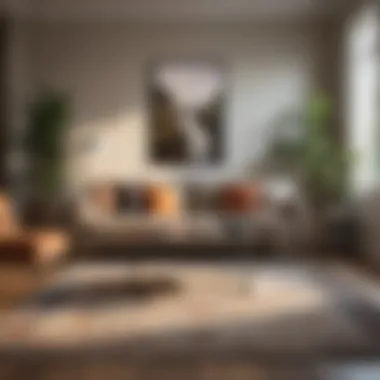

Pastel hues, such as light pinks or soft blues, contribute a gentle, airy feel. They complement beige without competing for attention. These colors can bring in a touch of playfulness and charm, making them ideal for casual or whimsical spaces.
When paired with a beige couch, pastel rugs can elicit a serene and calming atmosphere. It’s especially effective in bedrooms or children's rooms where tranquility is desired.
By selecting the right rug color, you not only enhance the visual appeal of your living area but also establish a mood that reflects your personal style.
Considering the various options presented, homeowners can make informed decisions based on their space and personal aesthetic. When selecting a rug color, always keep in mind how it interacts with the beige couch and the existing decor.
Patterns and Textures to Consider
Selecting a rug color for a beige couch involves more than just matching hues. Patterns and textures play a crucial role in the overall aesthetic and function of your living space. They can bring depth to a room, create interest, and express personal style. By carefully considering these elements, you can transform a simple arrangement into a dynamic and inviting area.
When pondering rug patterns, think about how they might interact with the surrounding decor. Some patterns can create a sense of movement, guiding the eye across the room. texutres contribute tactile experience and visual intrigue, making the space feel more inviting.
Key benefits of incorporating patterns and textures include:
- Visual Interest: Patterns can break up monotony and capture attention, while textures add richness to the space.
- Defining Areas: In open floor plans, rugs with distinct patterns can effectively demarcate different areas, enhancing functionality.
- Layering: The combination of different textures creates depth and complexity, allowing for a more curated look.
Geometric Patterns
Geometric patterns are a popular choice when pairing rugs with beige couches. They offer a modern touch and can enhance a minimalist or contemporary decor style. Geometric designs can vary from simple shapes to intricate arrangements, making it easier to find an option that fits your vision. Consider the scale of the pattern as well. Larger patterns may dominate the space, while smaller patterns can subtly complement other elements in the room.
For example, a rug featuring a bold geometric design in shades of blue or green can provide a striking contrast to the warm beige of your couch. This creates a sophisticated yet lively atmosphere.
Floral Designs
Floral rugs can introduce a sense of warmth and comfort to a beige couch setting. They evoke nature and can complement earthy tones well. Choose florals that mirror the colors found in other furnishings or decor items for a cohesive look.
Larger, more abstract floral patterns might work best in big spaces, while small, delicate floral designs can enhance smaller areas without overwhelming them. The key is to avoid clashing elements to maintain visual harmony.
Using floral designs wisely can help breathe life into the space, especially when combined with neutral or monochromatic accents.
Textured Rugs
Textured rugs can bring a layer of refinement and sophistication to your decor. They come in various materials, like wool, jute, or woven fibers, each offering distinct tactile qualities. A shaggy rug may offer a cozy touch underfoot, while a flatweave rug can provide a more structured look.
Incorporating texture can also help balance hard surfaces, such as wood or tile flooring. Consider how the texture interacts with light and movement within the space. For instance, a plush rug might appear more inviting in a soft-lit area, whereas a slick surface can reflect light beautifully, enhancing the overall brightness.
Impact of Room Size and Layout
The size and layout of a room play a crucial role in the overall design of a space. They influence not only the choice of furniture but also the selection of colors, including those of rugs. When considering a beige couch, understanding how these factors interplay can greatly enhance the aesthetic and functionality of a living area.
One important aspect to realize is that smaller spaces often require a different approach to color selection compared to larger rooms. In tighter areas, the color scheme should help to create a sense of openness, making the room feel larger and more inviting. Therefore, selecting rugs that align with this goal is essential. Lighter colors and subtle patterns can contribute to an airy atmosphere, while darker colors may risk making the space feel cramped.
Conversely, larger rooms provide more flexibility in design choices. In these areas, homeowners can afford to be bold with color palettes and textures. Larger rugs with rich colors or intricate patterns can serve as focal points, breaking up the space and adding visual interest. This dynamic can create a cozy environment even in expansive settings.
Choosing Colors for Small Spaces
- Light Tones: Soft beige, light gray, or pastel colors can open up smaller spaces. These hues reflect light and make the area feel spacious.
- Minimal Patterns: If you opt for patterns, consider delicate designs that do not overwhelm. Subtle geometric patterns or textures can add depth without causing visual clutter.
- Experimenting with Color: Use a monochromatic scheme by selecting a rug with variations of beige or very light neutral colors. This approach ties the room together and avoids harsh contrasts that can make the space feel unbalanced.
In summary, small rooms benefit from selecting rugs that enhance the feeling of space, thus allowing a harmonious design flow.
Enhancing Large Rooms
- Bold Colors: For larger areas, richer colors can establish a connection and bring warmth. Deep blues, rich browns, or even jewel tones can be successfully introduced as rug colors.
- Layering Textures: Consider using rugs with varied textures. A combination of a flat weave and a plush rug can create an inviting layer, emphasizing comfort in large spaces.
- Strategic Placement: The layout of furniture in larger rooms can guide rug placement. Use rugs to define areas, like a seating arrangement or a reading nook, which can help focus attention in multiple functional spaces.
Utilizing appropriate rug colors in larger rooms allows for creative possibilities. Homeowners can play with scales and contrast to craft an appealing interior that resonates with personal style and harmonizes with their beige couch.
Natural Light and Its Effects on Color Selection
Natural light plays a significant role in interior design, influencing how colors are perceived and making it essential to consider when selecting a rug for a beige couch. The natural light in a room can change throughout the day, affecting the appearance of colors. Therefore, understanding how different lighting conditions impact color choices can lead to more informed decisions.
Evaluating Color Under Different Lighting Conditions
To choose the right rug color, homeowners should first evaluate the natural light in their space. Morning and afternoon light has different qualities. For instance, morning light tends to be cooler, which can enhance blue or grey tones, making them appear more vibrant. In contrast, afternoon sunlight is warmer and may bring out the richness in earthy tones and warmer hues like rich browns and soft reds.
Homeowners can take advantage of this variability by observing how light enters the room at different times of day. Placing swatches of rug colors near the couch can help visualize how those colors interact with the beige and adjust according to natural lighting changes.
Artificial Lighting Influence
While natural light is crucial, artificial lighting also plays a key role in color selection. The type of bulbs used in a room—LED, incandescent, or fluorescent—can dramatically alter how colors are viewed. For example, incandescent lights emit a warmer glow, which can enhance the warm tones in beige and make certain rug colors feel more inviting.
Conversely, fluorescent lights may cast a harsher, cooler light that can detract from the richness of colors.
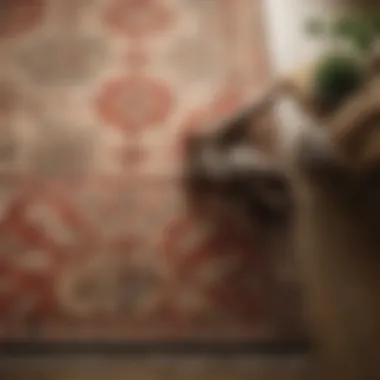
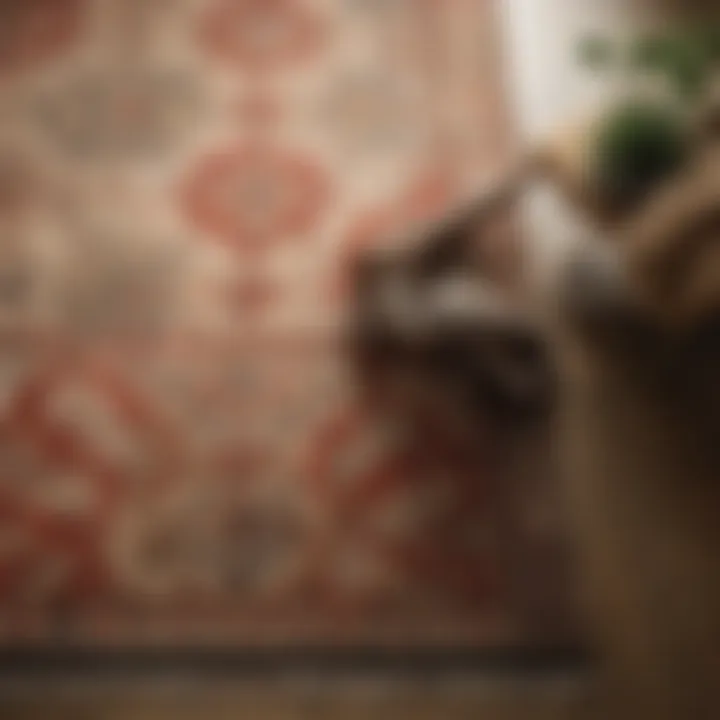
When selecting a rug, consider how it will look not just in daylight but also in the evenings under artificial lights. Here are a few tips to help:
- Test Color Swatches: Use fabric swatches under both natural and artificial light to see how they perform.
- Multiple Light Sources: Assess the effect of different light sources in the room to gain a comprehensive view of color under various conditions.
- Consider Bulb Type: Know the spectrum of your light bulbs to understand how they will impact your chosen color palette.
Remember: The goal is to ensure that the chosen rug harmonizes well with the beige couch in all lighting conditions, promoting a cohesive look in the space.
The Importance of Consistency and Cohesion
When selecting a rug color for a beige couch, consistency and cohesion are key elements that can significantly influence the overall aesthetic of your living space. Maintaining a unified design theme ensures that the room does not feel disjointed or chaotic. It creates a sense of harmony that enhances the comfort and appeal of your home. If every element in the room, including rugs, furniture, and decor, works together cohesively, the result will be a more inviting and pleasant environment.
Cohesion affects how colors and patterns interact with each other. By ensuring that the rug aligns with the existing color scheme and design elements, a homeowner can create a seamless transition that reflects personal style while remaining visually appealing. This approach not only supports the overall coherence within the space but also enhances its functionality and usability.
Maintaining a Unified Design Theme
A unified design theme acts as the backbone of effective interior decoration. When choosing rug colors, consider how these colors relate to the surrounding items. For instance, if your beige couch is paired with pastel-colored cushions, a rug in a similar muted tone can reinforce this palette. This doesn't mean everything must be the same color; rather, they should complement each other well.
When designing your space, think about:
- Color Matching: Choose rug colors that echo existing hues in your decor.
- Shared Patterns: If your cushions have a floral pattern, a rug with a similar motif can unify the look.
- Material Consistency: Selecting rugs that utilize similar materials as your sofa can enhance the tactile experience.
The goal is to weave together different elements in a manner that feels intentional and thoughtful.
Creating Flow Between Rooms
In any home's layout, especially open spaces, creating flow between rooms is crucial. A beige couch set in a living area may be complemented by a rug that also harmonizes with elements in adjacent rooms. For example, if a dining area shares visibility with the living room, utilizing similar tones or materials can help establish a smooth transition.
To achieve this, homeowners should:
- Use Complementary Colors: Ensure that the rug color resonates with tones used in other rooms.
- Employ Similar Textures: Rugs with similar textures or materials to items in adjacent spaces create a sense of continuity.
- Consider Design Style: Align the style of the rug with other elements around the home, whether modern, rustic, or classic.
Ultimately, a well-considered approach to the flow of design elements fosters a more integrated feel throughout the entire home.
Homeowner Case Studies
Homeowner case studies play a crucial role in understanding how different choices in rug color can affect overall interior design. These examples give practical insights into how real individuals have successfully chosen rugs that complement their beige couches. They reveal the thought process behind these selections and highlight the outcomes achieved, both aesthetically and functionally.
One key benefit of examining case studies is that they provide relatable scenarios. Homeowners can identify with the experiences of others who may have faced similar challenges or opportunities. These case studies may highlight factors specific to different living spaces, including size, layout, and light conditions, which all influence color choice. Through these narratives, readers will gain valuable lessons on the importance of personal style, practicality, and how a simple rug can transform a living area.
Moreover, case studies can illustrate the consequences of combining different elements of design. They can articulate how various rug colors interact with beige couches, contrasting with or complementing them based on the owner's vision. By analyzing successful cases, readers can avoid common pitfalls and replicate successful strategies in their homes. Understanding these patterns establishes a clearer path toward selecting a rug color that truly enhances their space.
"The right rug can link tones, create comfort, and establish a room's mood, especially when paired with neutral elements like beige."
Successful Living Room Designs
The case studies offer examples of design choices made in living rooms featuring beige couches. For instance, one case study showcases a modern living room where a deep blue rug beautifully complements the beige couch. The contrast adds depth to the space without overwhelming it. In this setup, the blue rug draws the eye, creating a focal point while maintaining a balanced atmosphere.
Homeowners selected not just a color but also considered texture and pattern. The chosen rug had a subtle pattern that added interest, while its material evoked warmth and comfort. Such thoughtful selections result in a living space that feels curated yet inviting.
Another example features a minimalist living room utilizing a light grey rug. Here, the homeowner effectively embraced a monochromatic scheme that enhances serenity. Such designs resonate with those who prefer simplicity and airy spaces, showcasing how a subtle choice can significantly influence the room's overall feel.
Transformative Before and After Comparisons
Before and after comparisons in these case studies reveal significant transformations achieved through careful rug selection. For one homeowner, a dated living room became revitalized with the introduction of a multicolored area rug. Initially, the beige couch appeared flat against the pale flooring and white walls. Adding a vibrant area rug created a visual anchor, infusing life into the space. The rich colors of the rug enhanced the beige of the couch, establishing a dynamic yet cohesive look.
These comparisons emphasize how profound an impact a rug can make. Homeowners often underestimate this element, assuming that color and style are secondary to more substantial furniture. However, the case studies demonstrate that an unassuming rug can redefine an environment. They remind readers that an engaging design does not always require dramatic changes; sometimes, a strategic update can yield striking results.
In summary, case studies offer concrete examples that illuminate the journey of choosing rug colors for beige couches. They provide context to decision-making processes, celebrating successful outcomes and helping inform future choices.
Final Thoughts on Rug Selection
When it comes to selecting a rug, particularly one that pairs well with a beige couch, several factors merit consideration. The flooring underneath, the existing decor, and, importantly, personal taste must harmonize. Understanding the influence of color, texture, pattern, and overall room dynamics creates a more nuanced approach to your design choices. This section encapsulates the key insights gathered through earlier discussions, reinforcing essential elements in making an informed selection.
A well-chosen rug not only provides comfort and warmth to a living space but also acts as a pivotal element that unifies various aspects of interior decor. Remember that a rug can define areas, enhance aesthetics, and introduce new elements into your color palette. Therefore, integrating both functional and aesthetic qualities into your rug choice is critical for creating a cohesive environment.
Balancing Aesthetics and Practicality
The balance between aesthetics and practicality is vital when making a rug choice. A beautiful rug might catch the eye, but considering its functionality is also crucial. For example, a family with pets might prefer a rug material that withstands wear and tear instead of delicate fabrics that may not hold up well. Similarly, in high-traffic areas, durability should take precedence over purely visual appeal.
- Fabric Selection: Choose materials such as polypropylene or jute for durability. They resist stains and are easy to clean.
- Color Considerations: Darker colors hide stains better than lighter ones. If the living area is prone to spills, consider a darker shade to maintain visual cleanliness.
- Maintenance Requirements: Some rugs require more care than others. Assess your willingness to maintain the rug and factor this into your decision-making process.
Balancing aesthetics with these practical aspects ensures that the rug becomes a lasting feature in your living space, rather than a temporary addition.
Personalizing Your Space
Your home reflects your identity, making personalization an essential aspect of your interior design choices. Choosing a rug that resonates with your style creates a sense of ownership and satisfaction in your space. Consider what elements speak to you personally, and how you can weave them into your overall decor.
- Color Preferences: Choose colors that evoke a sense of comfort or happiness for you. If you love vibrant colors, a rug with bold patterns might work well.
- Cultural Elements: Incorporating pieces that reflect your background or interests adds layers to your design. Traditional Persian rugs, for instance, tell a story and enhance a space's charm.
- Theme Consistency: Maintain consistency with the theme you want to portray, whether it’s modern, rustic, or eclectic. A carefully selected rug can bridge gaps between differing design elements.
Personalizing your space is not just about adding decoration; it is about creating an environment that feels like home. Consider how a rug will contribute to that warmth and individuality while coordinating with your beige couch.















